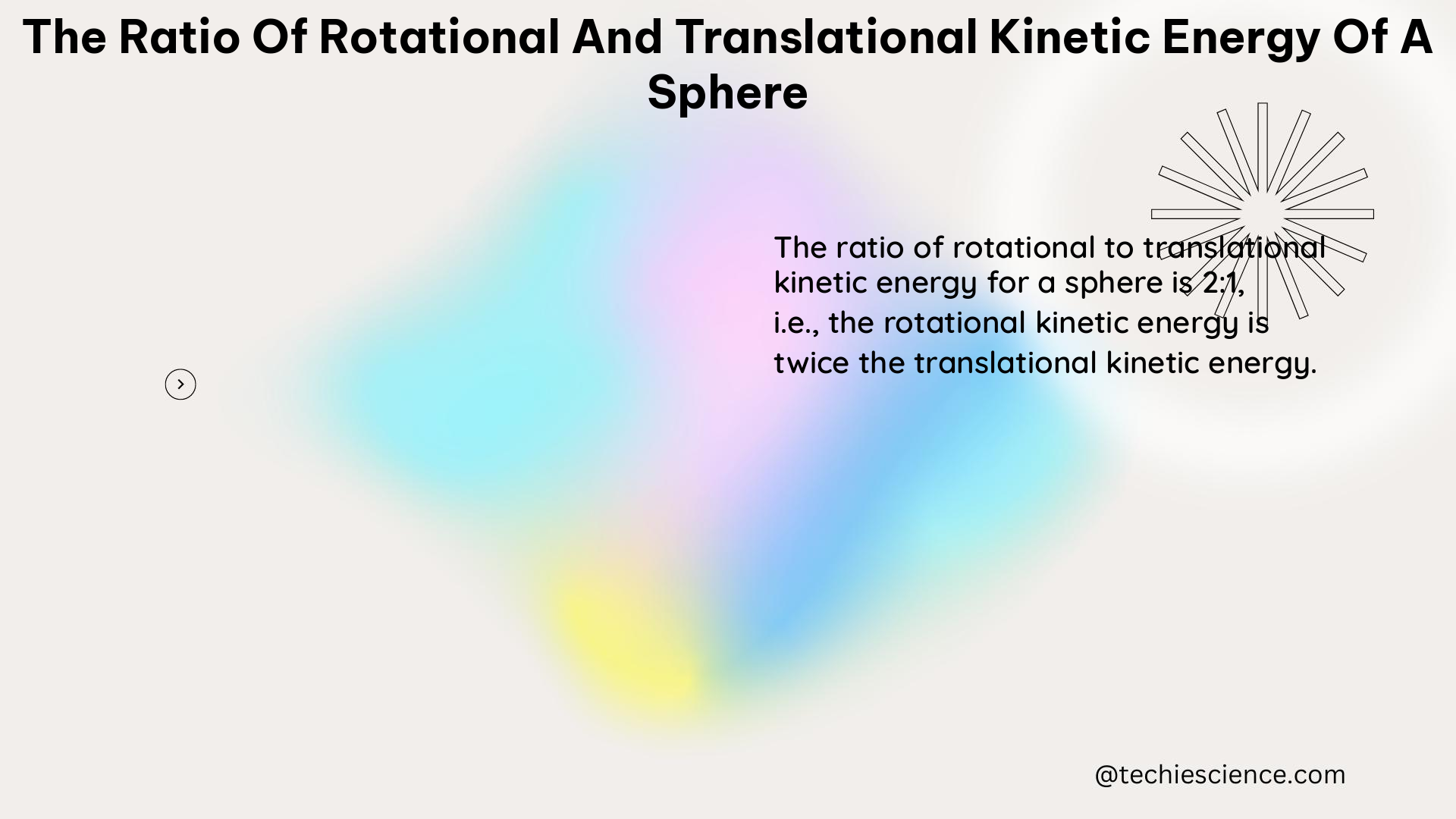Summary
The ratio of rotational to translational kinetic energy for a sphere depends on the sphere’s moment of inertia and its velocity. For a solid sphere, the ratio is 1/5, while for a hollow sphere, the ratio is 1/3. This article provides a detailed technical specification of the ratio, including the relevant formulas, derivations, and examples.
Moment of Inertia of a Sphere

The moment of inertia of a sphere is a measure of its resistance to rotational acceleration. For a solid sphere of mass m and radius r, the moment of inertia is given by:
I = (2/5)mr^2
For a hollow sphere of mass m and radius r, the moment of inertia is given by:
I = (2/3)mr^2
Kinetic Energy of a Sphere
The total kinetic energy of a sphere is the sum of its translational kinetic energy and its rotational kinetic energy.
The translational kinetic energy is given by:
KE_translational = (1/2)mv^2
where v is the velocity of the sphere’s center of mass.
The rotational kinetic energy is given by:
KE_rotational = (1/2)I*ω^2
where ω is the angular velocity of the sphere.
Relationship between Linear and Angular Velocity
For a sphere rolling without slipping, the linear velocity v of the center of mass is related to the angular velocity ω by:
v = r*ω
where r is the radius of the sphere.
Ratio of Rotational to Translational Kinetic Energy
Substituting the expressions for moment of inertia, translational kinetic energy, and rotational kinetic energy, we can derive the ratio of rotational to translational kinetic energy for a sphere.
For a solid sphere:
(KE_rotational)/(KE_translational) = [(1/2)(2/5)mr^2*ω^2]/[(1/2)mv^2] = (1/5)(r*ω/v)^2 = (1/5)
For a hollow sphere:
(KE_rotational)/(KE_translational) = [(1/2)(2/3)mr^2*ω^2]/[(1/2)mv^2] = (1/3)(r*ω/v)^2 = (1/3)
Therefore, the ratio of rotational to translational kinetic energy for a sphere depends on whether the sphere is solid or hollow:
- For a solid sphere, the ratio is 1/5.
- For a hollow sphere, the ratio is 1/3.
Examples and Numerical Problems
Example 1: A solid sphere of mass 2 kg and radius 0.1 m is rolling without slipping at a linear velocity of 5 m/s. Calculate the ratio of its rotational to translational kinetic energy.
Given:
– Mass, m = 2 kg
– Radius, r = 0.1 m
– Linear velocity, v = 5 m/s
Using the formula for a solid sphere:
(KE_rotational)/(KE_translational) = (1/5)(r*ω/v)^2
Since v = r*ω, we can substitute:
(KE_rotational)/(KE_translational) = (1/5)
Therefore, the ratio of rotational to translational kinetic energy for the solid sphere is 1/5.
Example 2: A hollow sphere of mass 3 kg and radius 0.2 m is rolling without slipping at a linear velocity of 8 m/s. Calculate the ratio of its rotational to translational kinetic energy.
Given:
– Mass, m = 3 kg
– Radius, r = 0.2 m
– Linear velocity, v = 8 m/s
Using the formula for a hollow sphere:
(KE_rotational)/(KE_translational) = (1/3)(r*ω/v)^2
Since v = r*ω, we can substitute:
(KE_rotational)/(KE_translational) = (1/3)
Therefore, the ratio of rotational to translational kinetic energy for the hollow sphere is 1/3.
Conclusion
In summary, the ratio of rotational to translational kinetic energy for a sphere depends on the sphere’s moment of inertia, which in turn depends on whether the sphere is solid or hollow. For a solid sphere, the ratio is 1/5, while for a hollow sphere, the ratio is 1/3. This relationship is derived from the formulas for moment of inertia, translational kinetic energy, and rotational kinetic energy, and is an important concept in the study of rotational dynamics.
References
- OpenStax, College Physics for AP® Courses, OpenStax, Houston, TX, 2018, pp. 282-285.
- HyperPhysics, “Rotational Kinetic Energy,” Georgia State University, accessed June 25, 2024, https://hyperphysics.phy-astr.gsu.edu/hbase/rotq.html.
- Khan Academy, “Rotational motion: work and energy,” accessed June 25, 2024, https://www.khanacademy.org/science/physics/torque-and-angular-momentum/rotational-work-and-energy/a/rotational-motion-work-and-energy.
Hi ….I am Abhishek Khambhata, have pursued B. Tech in Mechanical Engineering. Throughout four years of my engineering, I have designed and flown unmanned aerial vehicles. My forte is fluid mechanics and thermal engineering. My fourth-year project was based on the performance enhancement of unmanned aerial vehicles using solar technology. I would like to connect with like-minded people.